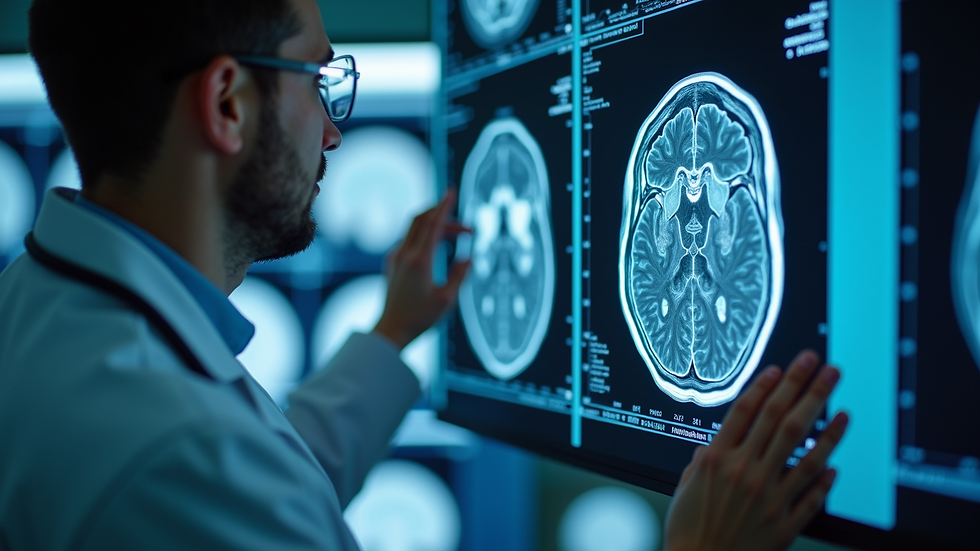Recognizing and Managing Traumatic Brain Injuries
- Holly Wild

- Aug 18
- 4 min read
When it comes to the delicate and complex world of brain health, few things are as urgent and impactful as understanding how to recognize and manage brain injuries. The brain, that intricate organ nestled within our skull, governs everything from our thoughts to our movements. So, when it sustains damage, the ripple effects can be profound and far-reaching.
If you or someone you care about has experienced a head injury, knowing the signs and the steps to take can make all the difference. Let’s embark on this journey together, exploring the nuances of brain injury management with clarity and compassion.
Understanding Brain Injury Management: What It Entails
Brain injury management is not just about immediate medical intervention; it’s a comprehensive approach that spans diagnosis, treatment, rehabilitation, and ongoing support. The brain’s complexity means that injuries can manifest in myriad ways - from subtle cognitive changes to severe physical impairments. Effective management requires a tailored plan that addresses the unique needs of each individual.
At its core, brain injury management involves:
Accurate diagnosis: Pinpointing the type and severity of the injury.
Medical treatment: Addressing acute symptoms and preventing complications.
Rehabilitation therapies: Physical, occupational, and speech therapies to regain lost functions.
Psychological support: Managing emotional and behavioral changes.
Family education and involvement: Empowering loved ones to provide the best care.
In the bustling NYC metropolitan area, access to specialized centers like the TBI Center of New York ensures that individuals receive expert care tailored to their circumstances. This holistic approach is vital because brain injuries are rarely one-dimensional; they affect the whole person.

Recognizing the Signs: When to Seek Help
One of the most challenging aspects of brain injury management is recognizing when a head injury has caused more than just a bump or bruise. Sometimes, symptoms appear immediately; other times, they unfold gradually, like a slow dawn revealing hidden shadows.
Common signs to watch for include:
Persistent headaches or dizziness
Confusion or difficulty concentrating
Memory problems or forgetfulness
Changes in mood or personality
Nausea or vomiting
Sensory issues such as blurred vision or ringing in the ears
Loss of consciousness, even briefly
If you notice any of these symptoms following a head trauma, it’s crucial to seek medical evaluation promptly. Early intervention can prevent complications and improve outcomes. Remember, even if the injury seems minor, the brain’s delicate nature means that subtle damage can have significant effects.
Imagine the brain as a finely tuned orchestra; even a slight disruption can throw the entire symphony off balance. That’s why vigilance and timely action are your best allies.

How do you deal with a traumatic brain injury?
Dealing with a traumatic brain injury is a journey that requires patience, resilience, and a well-structured plan. The path to recovery is often non-linear, with progress marked by small victories and occasional setbacks. Here’s a roadmap to help navigate this challenging terrain:
Immediate Medical Care
The first step is always to stabilize the individual and assess the injury’s severity. This may involve imaging tests like CT scans or MRIs, neurological exams, and monitoring for complications such as swelling or bleeding.
Developing a Personalized Treatment Plan
No two brain injuries are alike. Treatment plans should be customized, incorporating medications to manage symptoms, surgical interventions if necessary, and strategies to prevent secondary injuries.
Rehabilitation and Therapy
Rehabilitation is the cornerstone of brain injury management. Physical therapy helps restore movement and strength, occupational therapy focuses on daily living skills, and speech therapy addresses communication challenges. Cognitive rehabilitation can improve memory, attention, and problem-solving skills.
Emotional and Psychological Support
Brain injuries often bring emotional upheaval. Counseling, support groups, and psychiatric care can help manage depression, anxiety, and behavioral changes.
Family and Caregiver Involvement
Loved ones play a critical role in recovery. Educating families about the injury, expected challenges, and care techniques fosters a supportive environment that promotes healing.
Ongoing Monitoring and Adjustments
Recovery can span months or years. Regular follow-ups allow healthcare providers to adjust treatments and therapies as needed.
Throughout this process, it’s essential to celebrate progress, no matter how small. Recovery is a marathon, not a sprint, and every step forward is a testament to strength and determination.

Practical Tips for Daily Life After a Brain Injury
Adjusting to life after a brain injury can feel overwhelming. The changes in cognitive function, physical ability, and emotional state require new routines and coping strategies. Here are some practical tips to help manage daily life:
Create a structured routine: Consistency helps reduce confusion and anxiety.
Use memory aids: Calendars, alarms, and notes can support memory challenges.
Prioritize rest: The brain needs ample rest to heal; avoid overexertion.
Stay physically active: Gentle exercise promotes overall health and mood.
Maintain a healthy diet: Nutrition supports brain function and recovery.
Seek social support: Isolation can worsen emotional symptoms; stay connected.
Communicate openly: Share your needs and feelings with caregivers and healthcare providers.
Remember, adapting to new limitations doesn’t mean giving up on your goals. It means finding new ways to achieve them. Patience and self-compassion are your best friends on this path.
The Road Ahead: Embracing Hope and Healing
Navigating the aftermath of a brain injury is undeniably challenging, but it is also a journey filled with hope. Advances in medical science and rehabilitation techniques continue to improve outcomes for those affected. With the right support, many individuals regain significant function and quality of life.
If you or someone you know is facing this challenge, remember that expert help is available. Centers specializing in brain injury management, like the TBI Center of New York, offer comprehensive care designed to meet the unique needs of each patient. They stand as beacons of hope in the NYC area, guiding individuals toward recovery and renewed wellness.
In the end, managing a brain injury is about more than just healing the brain - it’s about restoring the essence of who you are and reclaiming your life’s narrative. So take heart, stay informed, and know that you are not alone on this path.
Thank you for joining me in this exploration of brain injury management. May this knowledge empower you or your loved ones to seek the care and support needed to thrive beyond injury.










Comments